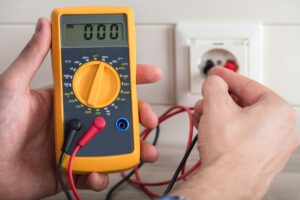Faulty wiring, overloaded circuits and ground faults are some of the most common electrical issues that home and business owners face.
This article explains these common faults in layman’s terms and explains why electrical fault finding should be entrusted to a professional, experienced electrician.
The Hidden Risks of Electrical Faults
The main risks associated with electrical faults are power outages, electrocution and fire.
Some faults can trip the entire system and are difficult to miss, such as when a whole building is left without power. Other faults are less obvious and can harm the inquisitive, whilst others lie in inaccessible areas like the roofspace, where sparks cannot be readily seen. If you suspect an electrical fault but ignore it, you greatly increase the risk of fire at your property.
Why DIY Fault Finding Won’t Always Cut it
While you might be able to tell that a power socket is overloaded or if a lightbulb has blown, DIY fault finding won’t help you identify more complex issues. DIY fault finding carries its own risks, particularly where wiring and grounding are concerned.
Ultimately, if you suspect an electrical fault, you should call a professional electrician to identify it for you.
Common Electrical Faults and Their Causes
Numerous electrical faults can occur in your property, but the most common include:
Overloaded Circuits
Electrical circuits can handle a certain amount or ‘load’ of electricity. Every electrical device, when using electricity, adds to the circuit’s load. When there are too many devices drawing more power than the circuit can handle, its built-in breaker (fuse) activates (or ‘trips’) and shuts off the power to the circuit.
Potential causes: Too many electrical appliances being used, bad wiring, circuit breaker issues, extreme weather.
Faulty Wiring
Another common issue is faulty wiring. Signs include flickering, dimming lights and regular breaker trips. Faulty wiring can be caused by a storm or even pests, but it is usually the result of poor wiring practices when initially installed.
Potential causes: Poor installation, too few outlets, ageing or damaged wiring.
Tripped Circuit Breakers
A circuit breaker is designed to interrupt current flow if a fault is detected. However, when a breaker trips repeatedly, it could indicate significant electrical issues within the property. Sometimes, a breaker trips because of overload during peak periods, but it can also be triggered by a faulty device or wiring issue.
Potential causes: Short circuit, overloaded circuit, appliance issues, corroded wires, ageing circuit breaker, damaged breaker.
Ground Faults
A ground fault can occur when an electrical current unintentionally flows directly to the ground, bypassing the circuit wiring. This can be caused by insulation breakdown or a short circuit, resulting in the circuit breaker tripping.
Potential causes: Short circuit, faulty appliances, damaged/incorrect wiring.
What is Electrical Fault Finding?
Electrical fault finding is a way of testing electrical equipment for potential issues and ensuring that it works safely and as expected. It’s best to hire a qualified and experienced electrician to identify faults, because there are many types of fault that can be challenging to identify and certain safety guidelines must be adhered to.
Types of Electrical Faults
A qualified electrician can identify the following electrical faults in your property:
- Overloaded circuits
- Faulty or ageing wiring
- Tripped circuit breakers
- Ground faults
- Electrical surges
- Dead or damaged outlets
- Electrical shocks
- Lighting issues
- Short circuits
Symptoms of Electrical Faults in Your Home or Business
Here are some signs to be aware of that could indicate an electrical fault at your property:
- Higher than average electricity bills
- Flickering or dimming lights
- The smell of burning from outlets or appliances
- A sparking electrical outlet
- Continuous tripping of a circuit breaker
- Electrical shocks from power outlets
- Hot outlets
- Regularly blown fuses
- Buzzing sounds at electrical outlets
- Exposed wiring
The Electrical Fault-Finding Process
If you suspect an electrical fault, act on your suspicion immediately. You may try to identify the problem yourself, but it is safer to bring in an experienced, qualified electrician. The following process is typically followed:
Conducting an Initial Assessment
The electrician will ask people on site about the potential fault. This is key to identifying a likely cause. An electrician will also visually assess the scene to see if there are any apparent signs of a fault.
Tools and Techniques Used
Electricians use specialised tools and techniques to identify electrical faults. Tools include a multimeter for measuring voltage, current and resistance and a circuit tester for detecting electricity in a wire or component. Tests are dependent on the suspected fault and include measuring insulation resistance, inspecting the meter box for tripped switches or simply plugging an electrical device into a different socket to see if it works.
Understanding the Results
After identifying the issue, the electrician will analyse his results and devise a plan to fix the electrical fault. Following the restoration, the electrician will conduct a test to see that they have successfully fixed the fault.
Why Professional Fault Finding is Essential
Professional fault finding is essential for the safety of your property. Some faults are obvious, whilst others are not:
Safety Concerns with DIY Electrical Work
The electrical system of any property is complex. Wiring, circuit boards, fuses, breakers and grounding are just some components involved in the supply of electricity to your property. Laws and safety guidelines around electricity and electrical contractors are specifically in place to deter unlicensed homeowners from having a go at fixing electrical problems themselves.
To the untrained eye, it can be difficult to know what you’re looking at, and if you start poking around, you can end up doing more harm than good. You may also increase the risk of immediate electrocution and fire.
The Expertise of Professional Electricians
Hiring a licensed, experienced electrician is the safest and quickest way when trying to pinpoint an electrical fault. Experienced electricians are trained to identify faults and should be able to diagnose the issue efficiently before implementing a safe solution.
Proactive Electrical Maintenance is Key
The sooner you can identify an electrical fault, the better. When proactively and regularly checking appliance cords for wear and tear, make a note if you think your circuits are tripping a bit too often. Stop using appliances, power points or switches if they affect the property’s power supply when used. If your property is older or has just encountered some extreme weather conditions, as soon as you think there’s a problem, contact us at NJP Electrical Services. We’re here to help.



